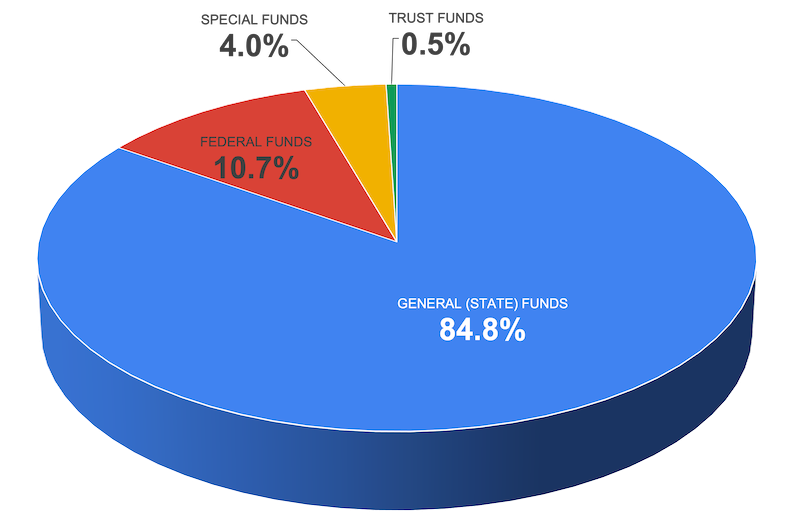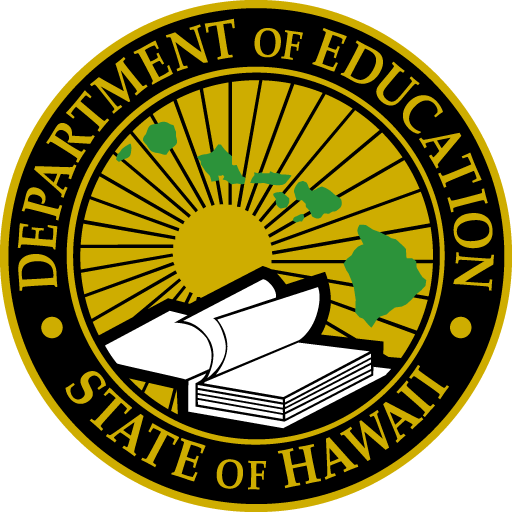Ang badyet ng Kagawaran ng Edukasyon ng Estado ng Hawai'i ay gumaganap ng mahalagang papel sa pagsuporta sa tagumpay ng mag-aaral at pagpapanatili ng kalidad ng ating sistema ng pampublikong paaralan. Ang aming badyet ay nahahati sa dalawang pangunahing bahagi: ang badyet sa pagpapatakbo at ang badyet ng Capital Improvements Program (CIP).
Appropriation → | → Allocation → | → Allotment → | → Expenditure |
Resources that have been or are in the process of being approved by the Legislature and have become law. (Legislative Reference Bureau – The Budget Process) | Appropriation amounts provided (“allocated”) to programs to create expenditures plans. Allocated amount could be less than Appropriation due to restrictions set forth by the Governor or by the Department depending on the fiscal conditions of the time. | Once the Expenditure plans are completed and approved, resources are loaded (“allotted”) into the Financial Management System allowing programs to begin spending their allotted resources. | Actual use of the resources for payroll and by either purchasing or encumbering goods or services. |
Ang $2.18 bilyong badyet sa pagpapatakbo para sa taon ng pananalapi 2024-25, na pangunahing pinondohan ng kita ng buwis ng estado, ay sumasaklaw sa pang-araw-araw na operasyon ng mga paaralan at opisina, mula sa mga suweldo ng guro hanggang sa mga mapagkukunan sa silid-aralan. Samantala, ang badyet ng CIP ay nakatuon sa pagpapaunlad, pagpapanatili at pag-upgrade ng mga pasilidad ng paaralan, na pinondohan halos lahat sa pamamagitan ng mga bono ng estado.
Sama-sama, tinitiyak ng mga badyet na ito na ang ating mga paaralan ay may kagamitan upang magbigay ng ligtas, nakakaengganyo at epektibong kapaligiran sa pag-aaral para sa lahat ng mga mag-aaral. Matuto nang higit pa tungkol sa mga badyet ng Departamento sa ibaba.
TIMELINE
This is a timeline of major events of the Department’s operating budget appropriations.
Petsa | Organisasyon | Description |
|---|---|---|
5/2/2025 | Legislature | House Finance and Senate Ways and Means releases Committee Report and bill format of budget bill HB300 SD1. • Budget Worksheet (see EDN 100, 150, 200, 300, 400, and 500) |
4/16/2025 | Department of Taxation | The Council on Revenues held a meeting to forecast revenue growth for the General Fund on March 12th, 2025. • The Council lowered its forecast to 5.0% from 6.4% for Fiscal Year (FY) 2025. It also lowered the forecast to -2.25% from -1.5% for FY 2026. The forecast for FYs 2027, 2028, 2029, 2030, and 2031 was left unchanged at 2.9%, 3.5%, 2.6%, 1.9%, and 3.1%, respectively. • Presentation |
4/8/2025 | Legislature | Senate Ways and Means releases Committee Report and bill format of budget bill HB300 SD1. • Budget Worksheet (see EDN 100, 150, 200, 300, 400, and 500) |
3/11/2025 | Legislature | House Finance releases Committee Report and bill format of budget bill HB300 HD1. • Budget Worksheet (see EDN 100, 150, 200, 300, 400, and 500) |
1/21/2025 | Legislature | Budget Bill Introduced HB300 |
1/14/2025 | Legislature | Senate Committee on Ways and Means and Education budget briefing for the Department of Education at 1:00 PM. • Informational Briefing Notice • Briefing Materials |
1/13/2025 | Legislature | House Committee on Education Budget Briefing for the Department of Education at 2:00 PM. • Informational Briefing Notice |
1/10/2025 | Department of Taxation | The Council on Revenues held a meeting to forecast revenue growth for the General Fund on January 8th, 2025. • The Council increased the FY 2025 forecast and lowered the forecast for FY 2026-2029. • Presentation |
1/10/2025 | Legislature | House Committee on Finance Budget Briefing for the Department of Education at 9:00AM. • Informational Briefing Notice • Briefing Materials |
12/12/2024 | Board of EducationFinance and Infrastructure Committee meeting | Update on Governor’s Decision on FB 2025-27 Budget: • CIP Budget – Agenda Item III • Operating Budget – Agenda Item IV |
11/27/2024 | Department of Budget and Finance | FM 24-17 Governor’s Decisions on FB 2025-27 Executive Budget Requests: • FM 24-17 Attachment – EDN (Pg. 1-30) |
11/25/2024 | Hawaii State Legislature | |
11/13/2024 | Department of Budget and Finance | FM 24-16 Department of Budget and Finance’s Recommendations on FB 2025-27 Executive Budget Requests: • FM 24-16 Attachment – EDN (Pg. 1-25) |
10/22/2024 | Board of EducationFinance and Infrastructure Committee meeting | |
9/26/2024 | Department of Budget and Finance | FM 24-10 Fiscal Biennium 2025-27 Executive Budget Request and the Program and Financial Plan for the Period 2025-31: • Attachment 1 • Attachment 2 • Attachment 3 • Attachment 4 • Attachment 5 • Attachment 6 • Attachment 7 |
9/17/2024 | Department of Budget and Finance | |
9/10/2024 | Department of Taxation | The Council on Revenues held a meeting to forecast revenue growth for the General Fund on September 5th, 2024. • While the Council expects relatively solid economic growth for the current and subsequent fiscal years, it lowered its forecast because of the significant tax relief legislation passed in the 2024 Legislature. • Presentation |
7/26/2024 | Department of Budget and Finance | FM 24-07 Program Memoranda for Major Programs in the Statewide Program Structure |
7/9/2024 | Governor | HB1800 Budget Bill signed into law and enacted as ACT 230, SLH 2024 • DOE programs (EDN 100, 150, 200, 300, 400, and 500) start on page 40. • GIA’s start on page 68. • Capital Improvement Projects with EDN program codes start on page 201 |
5/31/2024 | Department of Budget and Finance | FM 24-05 Review of the Program Structure and Performance Measures. • Education – FB 25-27 Executive Budget Program Structure |
Badyet sa Pagpapatakbo
Mga Pinagmumulan ng Pagpopondo

Ang piskal na taon 2024-25 operating budget funding ay nagmumula sa apat na pinagmumulan:
- Pangkalahatang pondo: Kinakatawan ang humigit-kumulang 85% ng aming mga mapagkukunan ng pagpopondo. Nagmula sa pangkalahatang pondo ng Estado ng Hawaiʻi, pangunahin ang mga kita sa buwis ng estado. Ito ang pinakamataas na pinagmumulan ng pondo sa Kagawaran.
- Pederal na pondo: Ang pangalawang pinakamalaking pinagmumulan ng pagpopondo ay kumakatawan sa humigit-kumulang 11% sa mga mapagkukunan ng kisame sa paggasta. Ang Departamento ay tumatanggap ng mga gawad mula sa mga pederal na ahensya kabilang ang US Departments of Education, Agriculture, Defense at Health at Human Services.
- Mga espesyal na pondo: Humigit-kumulang 4% ng aming mapagkukunan ng kisame sa paggasta ay sa pamamagitan ng mga espesyal na pondo. Ang mga nagmumula sa mga aktibidad na kumikita ng kita, kabilang ang mga serbisyo ng pagkain sa paaralan, mga serbisyo sa transportasyon ng bus ng mag-aaral, programa ng summer school, mga programa pagkatapos ng paaralan, edukasyon para sa mga nasa hustong gulang, edukasyon sa pagmamaneho, at paggamit ng mga pasilidad ng paaralan.
- Trust funds: Maaaring kasama ang mga donasyon at regalo, mga pundasyon at iba pang mga gawad, mga koleksyon ng aktibidad sa programang pampalakasan sa paaralan, at “patas na bahagi”.
Direct-to-School Funding
- EDN 100 ay halos ganap na ipinamamahagi sa mga paaralan gamit ang Weighted Student Formula (WSF). Ang WSF ay nagbibigay sa mga paaralan ng isang partikular na halaga ng dolyar para sa bawat mag-aaral, at karagdagang mga pondo para sa mga mag-aaral na may ilang partikular na katangian, tulad ng pagiging kwalipikado para sa libre at pinababang programa sa tanghalian (socio-economicly challenged) o pagiging English language learners. Lumilikha ito ng isang transparent na modelo ng equity sa pagpopondo sa isang buong estado na batayan. Ang balanse ng EDN 100 ay ginagamit upang suportahan ang mga programa tulad ng athletics, JROTC at Alternative Learning Centers.
- EDN 150 sumusuporta espesyal na edukasyon mga mag-aaral na maaaring mangailangan o magkaroon ng Individualized Education Plan.
- EDN 400 nagbabayad ng mga bayarin sa paaralan kabilang ang imburnal, kuryente, tubig, pagkukumpuni, serbisyo sa pagkain at iba pa.
- EDN 500 nagbabayad para sa mga programang Pang-adulto na Edukasyon sa mga pampublikong paaralan.
Suportahan ang Pagpopondo sa Mga Antas ng Paaralan, Distrito, at Estado
Ang natitira sa badyet ay ikinakalat sa mga EDN 200 at 300, na nagbibigay ng suporta sa lahat ng antas. Kabilang dito ang mga suporta sa pagtuturo, pagsusuri sa buong estado, suportang pang-administratibo (mga tauhan, teknolohiya at pananalapi), mga programang pangkomunidad gaya ng A+ at edukasyong pang-adulto, pangangasiwa ng kumplikadong lugar, opisina ng maagang pag-aaral upang magkaloob ng mga programa bago ang kindergarten, gayundin ang Board of Education at Office of the Superintendent.
Mga Ahensya (By EDN) na Nagpapatakbo sa Labas ng Kagawaran ng Edukasyon
- EDN 407 Mga Pampublikong Aklatan
- EDN 450 Awtoridad sa Pasilidad ng Paaralan
- EDN 600 Mga Paaralang Charter
- EDN 612 Komisyon at Pangangasiwa ng Charter Schools
- EDN 700 Executive Office on Early Learning
Non-facility general fund per-pupil funding request for charter school students
The general fund per-pupil amounts, not including charter school facilities (CIP) shall be the same as the general fund per-pupil for HIDOE schools as explained in HRS 302D-28.
- The process involves two phases, first, a budget appropriation request and then later, an allocation “true-up” to adjust for any differences.
- For the budget appropriation request, the Department of Budget and Finance Director of Finance submits to the Legislature a request based on projections for consideration in the final Budget Appropriations Act [HRS 302D-28(a) and (b)].
- The appropriation request is reflected in the Charter School’s per pupil program.
- For the budget appropriation request, the Department of Budget and Finance Director of Finance submits to the Legislature a request based on projections for consideration in the final Budget Appropriations Act [HRS 302D-28(a) and (b)].
- After the Appropriations Act is finalized, the Director of Finance ensures that an allocation “true up” is done using the October 15th student enrollment count. The true up equalizes the per-pupil funding for both entities [HRS 302D-28(c)]
Capital Improvements Program (CIP)
Ang Capital improvement Budget (CIP) budget is set by the state as part of a comprehensive program to manage state facilities, and is handled separately from the operating budget. Facilities staff work with complex area superintendents and principals to prioritize school-level needs.
Budget Allocations
Below are links to databases containing allocations for Department offices, districts, and schools. You can view the data by allocation number, program or organization.
